Giuseppe Bonifazi, Giuseppe Capobianco, Roberta Palmieri and Silvia Serranti*
Department of Chemical Engineering, Materials & Environment (DICMA), Sapienza University of Rome, Via Eudossiana 18, 00184, Rome, Italy. E-mail: [email protected]
DOI: https://doi.org/10.1255/sew.2019.a2
© 2019
Introduction
The need to develop and deploy increasingly effective, fast and robust sensing techniques capable of detecting, characterising and sorting solid waste products and materials represents one of the most challenging aspects in the industrial recycling sector. Most waste is of low value, so innovative technologies must be cost-effective and, at the same time, achieve high performance in terms of materials identification, both for sorting and quality control in recycling plants, so as to end up with high-quality secondary raw materials that are competitive in the market with the corresponding primary raw materials. In this perspective, the use of hyperspectral imaging (HSI) technology to carry out products/materials characterisation, through fast and reliable handling/processing, is becoming more and more important. In this article, some HSI-based applications in the waste recycling sector, originally developed by the authors, are presented and discussed. All the procedures have been designed, implemented and set up with the aim of providing sensing/inspection tools able to perform non-invasive, contactless and real-time analyses at both laboratory and/or industrial scale.
Hyperspectral imaging
Hyperspectral imaging is an innovative technique that combines the properties of digital imaging with those of spectroscopy.1 Using this approach, it is possible to detect the spectral signature of each pixel of the acquired image in different wavelength regions (visible, near infrared, short-wave infrared etc.) according to the characteristics of the selected sensing device. A hyperspectral image can thus be considered as a three-dimensional dataset with two spatial dimensions and one spectral dimension, the so-called “hypercube”. HSI can be considered one of the best and most powerful non-destructive technologies for accurate and detailed information extraction from the acquired images, with a high level of flexibility.
The large amount of spectral information collected by HSI from the sample surfaces must be processed in order to extract the information of interest. Furthermore, as a preliminary step in any inspection or quality control logic development, hyperspectral libraries of reference spectra, to be utilised for unknown sample recognition, must be built. To reach the previously mentioned goals, algorithms and procedures for spectral data pre-processing, exploration and classification are usually implemented through chemometric strategies. Different pre-preprocessing algorithms can be applied to hyperspectral data, finalised to linearise relationships among variables and remove external sources of variation that are not of particular interest for the analysis. Principal Component Analysis (PCA) is applied for exploratory purposes, providing an overview of the complex multivariate data.2 PCA decomposes spectral data into several principal components (PCs), linear combinations of the original data, embedding the spectral variations of each collected spectral data set. The first few PCs, resulting from PCA, are used to analyse the common features among samples: in fact, samples characterised by similar spectral signatures tend to aggregate in the score plot as a cluster.
Finally, the recognition of different products and/or materials is obtained utilising classification methods, such as Partial Least-Squares Discriminant Analysis (PLS-DA). PLS-DA is a supervised classification technique requiring prior knowledge of the data and allowing the classification of samples into predefined groups.3 In order to do that, starting from reference samples, a discriminant function is built and then this is later applied to classify samples belonging to an unknown set. Once the model is built, it can be applied to validation images. An interesting and powerful classification method is hierarchical modelling. Adopting this kind of classification logic,4 objects are divided into subsets and then they are split again into further subsets, until each of them contains only a single object. During each step, objects that are different from the others are selected, isolated and compared through successive PLS-DA classification models.
Applications to the solid waste recycling sector
The utilisation of expensive and/or sophisticated devices is not appropriate in the waste recycling sector for several reasons. These are mainly technical (e.g. particles of different size, shape, composition, physical status), environmental (e.g. harsh conditions) and economic (e.g. low values of recovered materials or products). Therefore, efficient, but low-cost, technologies for the characterisation, sorting and quality control of the waste and recycled products are needed. A solution is represented by the application of procedures based on the utilisation of HSI devices. These procedures are growing rapidly in the waste management sector for materials coming from different sources, i.e. Construction and Demolition Waste (CDW), Waste from Electric and Electronic Equipment (WEEE), Municipal Solid Waste (MSW) and End-of-Life Vehicles (ELV). Below, two different case studies related to the solid waste recycling sector are reported; the first one deals with end-of-life concrete and the second one with mixed plastic waste.
HSI sensing devices
Two different HSI-based sensing architectures have been utilised, both located at the Raw Materials Laboratory of the Department of Chemical Engineering, Materials & Environment (Sapienza - University of Rome).
The first HSI device works in the NIR range (1000-1700 nm) and consists of a Spectral Camera NIR (SPECIM Ltd, Finland) using an ImSpector™ N17E with a spectral sampling/pixel of 2.6 nm, coupled with a TE-cooled InGaAs photodiode array sensor (320 × 240 pixels) and a pixel resolution of 12 bits. The device is fully controlled by a PC unit. Objects/materials to be investigated are laid on a moving conveyor belt (width = 26 cm and length = 160 cm) with adjustable speed (variable between 0 mm s–1 and 50 mm s–1). Spectra acquisition can be carried out continuously or at specific time intervals. The lighting source uses a diffused light cylinder architecture, optimised for the NIR (i.e. hosting cylinder aluminium internal coated), embedding five halogen lamps.
The second HSI device works in the SWIR range (1000–2500 nm) and is made up of a SISUChema XL™ Chemical Imaging Workstation (Specim, Finland), with an ImSpector™ N25E imaging spectrograph, having a spectral sampling/pixel of 6.3 nm [active pixel 320 (spatial) × 240 (spectral) pixels], coupled with a MCT camera with pixel resolution of 14 bits. The device is controlled by a PC unit equipped with the ChemaDAQ™ data acquisition software (Specim, Finland). Objects/materials to investigate are placed into a moving sample tray/s.
In both cases the acquired hyperspectral images were processed using the PLS_Toolbox (Eigenvector Research, Inc.) running inside Matlab® (The Mathworks, Inc.).
End-of-life concrete
The possibility to utilise efficient and reliable sensing technologies able to perform detection/control actions, in order to assess concrete physical–chemical characteristics before demolition and during the recycling process of the different constituents, represents a key issue for the demolition waste sector.5–7 Particular attention has been devoted in recent years to the recycling of concrete aggregates, contributing to reducing non-renewable natural resources exploitation. Characterisation of the aggregates during each step of the end-of-life concrete recycling process is important in order to obtain a final product able to satisfy market and regulatory requirements, with technical properties comparable with those of primary raw materials. In more detail, in order to recycle aggregates from concrete, two important aspects that can affect quality must be taken into account: 1) the presence of materials considered as pollutants (i.e. plastic, foam, brick, wood, gypsum) with respect to the aggregates5 and 2) the degree of removal of mortar paste from the surface of recycled concrete aggregates.6
HSI was successfully used to recognise and identify the pollutants in a recycled aggregates stream as well as to evaluate the degree of removal of mortar paste from aggregates’ surfaces. For contaminant detection, the investigated materials are characterised by different spectral signatures in the NIR range (1000–1700 nm) (Figure 1a). PCA shows the variance differences between the analysed classes of the materials. In fact, as shown in the score plot (Figure 1b), it is possible to observe the presence of six different clusters, based on the grouping of pixels according to their spectral similarity, corresponding to the different materials. After exploring the data by PCA, PLS-DA was applied as the classification method (Figure 1c). The six-class model gives a good classification, as shown in Figure 1d. Furthermore, it was also possible to correctly identify the mortar attached to the aggregate surface, as shown in Figures 1e–1f. In fact, using a two-class PLS-DA model (i.e. mortar and aggregate classes), it was possible to identify clean aggregates, aggregates totally covered by mortar paste and aggregates partially-covered by mortar paste. The sensitivity and the specificity values of the model built for contaminants are reported in Table 1. Sensitivity measures the actual positive values identified as such, whereas specificity measures the negative values correctly identified. A perfect prediction model is characterised by values of sensitivity and specificity equal to 1.
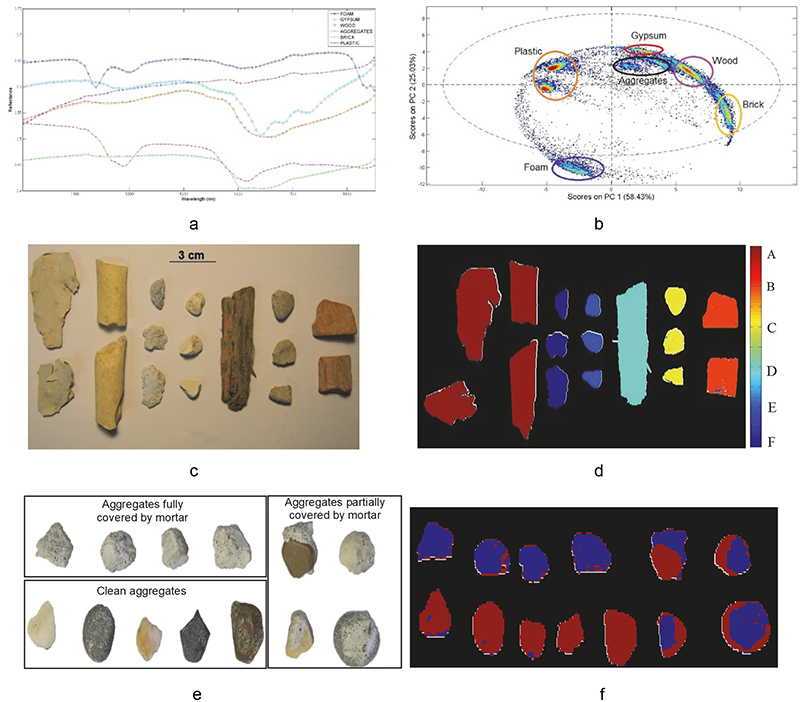
Figure 1. a: Average reflectance spectra of the different materials identified inside the EOL concrete waste stream; b: PCA score plot; c: source digital image; and d: corresponding classified hyperspectral image. Plastic (A), brick (B), concrete aggregates (C), wood (D), gypsum (E) and foam (F); e: source digital image of recycled concrete aggregates; f: corresponding classified hyperspectral image (red: clean aggregate surface; blue: mortar).
Table 1. Sensitivity and specificity values for the six-classes PLS-DA built for the different concrete contaminants.
Class | Sensitivity | Specificity | ||
Calibration | Cross validation | Calibration | Cross validation | |
Aggregates | 0.993 | 0.995 | 0.004 | 0.062 |
Brick | 0.997 | 1.000 | 0.996 | 0.996 |
Gypsum | 0.984 | 1.000 | 0.999 | 0.999 |
Plastic | 1.000 | 1.000 | 1.000 | 1.000 |
Wood | 0.982 | 0.983 | 0.994 | 0.825 |
Foam | 1.000 | 1.000 | 1.000 | 1.000 |
Mixed plastic waste
Nowadays, there is an urgent need to recycle increasing amounts of plastic waste, and to improve the recycling strategies currently adopted in this field in order to identify and sort the different types of plastics into single polymer streams, especially with reference to those most difficult to be separated by commonly used technologies. In order to produce high-quality plastic products for the market in secondary raw materials, it is in fact necessary to obtain mono-polymer streams characterised by very low levels of contamination from other polymers.8 Efforts must be made to achieve a high quality standard for plastic recycling, both in terms of products fed to recycling plants and the final recovered product characteristics. The possibility of using HSI to implement analytical logics able to sort different polymers and/or to provide an accurate quality certification of products, can contribute to achieve this goal. Based on the experience developed by the Authors in hyperspectral imaging for the recognition of different plastic waste coming from different sources,8–14 a flexible hierarchical classification model based on PLS-DA has been developed and implemented to classify many classes of polymers at the same time. In more detail, HSI in the short-wave infrared range (1000–2500 nm) was applied to identify eight different classes of polymers, representing the most used ones in many different applications and products (packaging, construction, electronic appliances, vehicles etc.): HDPE, LDPE, PA, PET, POM, PP, PS and PVC. In Figure 2a, the average reflectance spectra of the analysed plastics are reported, showing different characteristics useful for their further recognition. After exploring polymer spectral differences by PCA (Figure 2b), a hierarchical PLS-DA model was built, allowing the identification of the eight different polymer classes (Figures 2c and 2d). The proposed methodology, based on hierarchical classification, is very powerful and fast, allowing the eight different polymers to be identified in a single step.
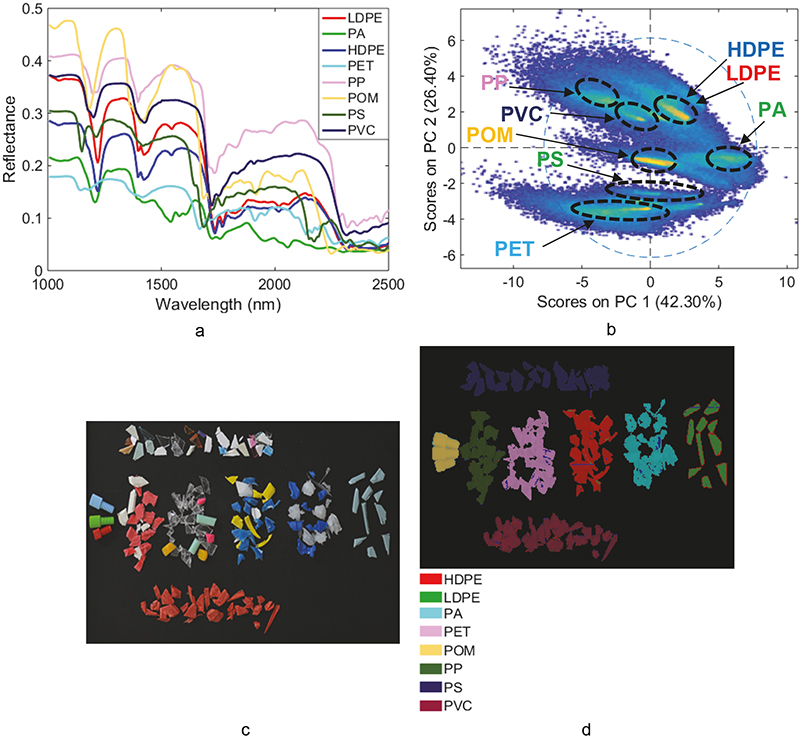
Figure 2. a: Average reflectance spectra of the different classes of polymer waste samples; b: PCA score plot; c: source digital image of different plastic flakes; d: corresponding classified hyperspectral image.
The sensitivity and specificity values obtained for the built model are presented in Table 2. The values are very good, ranging from 0.953 to 1.000 for both parameters. The proposed HSI approach has many advantages, being fast, non-destructive and accurate, without any need to perform specific sample preparation.
Table 2. Sensitivity and specificity for the eight-class hierarchical PLS-DA built for the different plastic samples.
Class | Sensitivity | Specificity | ||
Calibration | Cross validation | Calibration | Cross validation | |
LDPE | 0.993 | 0.993 | 0.998 | 0.998 |
PA | 1.000 | 1.000 | 0.953 | 0.953 |
HDPE | 0.998 | 0.998 | 0.993 | 0.993 |
PET | 0.999 | 0.999 | 0.998 | 0.998 |
PP | 0.992 | 0.992 | 1.000 | 1.000 |
POM | 0.953 | 0.953 | 1.000 | 1.000 |
PS | 0.998 | 0.998 | 0.999 | 0.999 |
PVC | 1.000 | 1.000 | 1.000 | 0.992 |
Conclusions
HSI can be profitably applied in the waste recycling sector to develop innovative analytical procedures (laboratory scale) and sorting or quality control strategies (industrial scale) specifically targetted to solve classification/identification problems related to the detection of different materials and related characteristics, unwanted contaminants etc., sometimes difficult to “qualify” and “quantify” through conventional strategies. The use of HSI and the development of procedures for extraction of useful information based on chemometric strategies were successfully applied to two different complex waste streams, i.e. end-of-life concrete and mixed plastic waste. The characteristics of the devices and the potential offered by chemometric tools, allow such an approach to be used to set-up innovative, flexible, reliable and low-cost detection/control devices and strategies that can be easily integrated, both at laboratory and industrial level, as well as inside existing consolidated analytical path and/or processing plant layouts.
References
- P. Geladi, H. Grahn and J. Burger (Eds), Multivariate Images, Hyperspectral Imaging: Background and Equipment, Techniques and Applications of Hyperspectral Image Analysis. John Wiley & Sons, Chichester, pp. 1–15 (2007).
- S. Wold, K. Esbensen and P. Geladi, “Principal component analysis”, Chemometr. Intell. Lab. Syst. 2, 37–52 (1987). https://doi.org/10.1016/0169-7439(87)80084-9
- D. Ballabio and V. Consonni, “Classification tools in chemistry. Part 1: linear models. PLS-DA”, Anal. Methods 5, 3790–3798 (2013). https://doi.org/10.1039/c3ay40582f
- J.A. Westerhuis, T. Kourti and J.F. MacGregor, “Analysis of multiblock and hierarchical PCA and PLS models”, J. Chemometr. 12(5), 301–321 (1998). https://doi.org/10.1002/(SICI)1099-128X(199809/10)12:5<301::AID-CEM515>3.0.CO;2-S
- S. Serranti, R. Palmieri and G. Bonifazi, “Hyperspectral imaging applied to demolition waste recycling: an innovative approach for quality control”, J. Electron. Imaging 24, 043003 (2015). https://doi.org/10.1117/1.JEI.24.4.043003
- G. Bonifazi, R. Palmieri and S. Serranti, “Evaluation of attached mortar on recycled concrete aggregates by hyperspectral imaging”, Constr. Build. Mater. 169, 835–842 (2018). https://doi.org/10.1016/j.conbuildmat.2018.03.048
- G. Bonifazi, R. Palmieri and S. Serranti, “Concrete drill core characterization finalized to optimal dismantling and aggregates recovery”, Waste Manage. 60, 301–310 (2017). https://doi.org/10.1016/j.wasman.2016.10.008
- S. Serranti, A. Gargiulo and G. Bonifazi, “Characterization of post-consumer polyolefin wastes by hyperspectral imaging for quality control in recycling process, Waste Manage. 31, 11, 2217–2227 (2011). https://doi.org/10.1016/j.wasman.2011.06.007
- S. Serranti S., A. Gargiulo and G. Bonifazi, Classification of polyolefins from building and construction waste using NIR hyperspectral imaging system”, Resour. Conserv. Recycl. 61, 52–58 (2012). https://doi.org/10.1016/j.resconrec.2012.01.007
- B. Hu, S. Serranti, N. Fraunholcz, F. Di Maio and G. Bonifazi, “Recycling-oriented characterization of polyolefin packaging waste”, Waste Manage. 33, 574–584 (2013). https://doi.org/10.1016/j.wasman.2012.11.018
- A. Ulrici, S. Serranti, C. Ferrari, D. Cesare, G. Foca and G. Bonifazi, “Efficient chemometric strategies for PET-PLA discrimination in recycling plants using hyperspectral imaging”, Chemometr. Intell. Lab. Syst. 122, 31–39 (2013). https://doi.org/10.1016/j.chemolab.2013.01.001
- R. Palmieri, G. Bonifazi and S. Serranti, “Recycling-oriented characterization of plastic frames and printed circuit boards from mobile phones by electronic and chemical imaging”, Waste Manage. 34, 2120–2130 (2014). https://doi.org/10.1016/j.wasman.2014.06.003
- V. Luciani, G. Bonifazi, B. Hu, P. Rem and S. Serranti, “Upgrading of PVC rich wastes by magnetic density separation and hyperspectral imaging quality control”, Waste Manage. 45, 118–125 (2015). https://doi.org/10.1016/j.wasman.2014.10.015
- G. Bonifazi, G. Capobianco and S. Serranti, “A hierarchical classification approach for recognition of low-density (LDPE) and high-density polyethylene (HDPE) in mixed plastic waste based on short-wave infrared (SWIR) hyperspectral imaging”, Spectrochim. Acta A 198, 115–122 (2018). https://doi.org/10.1016/j.saa.2018.03.006


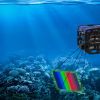
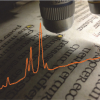
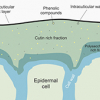
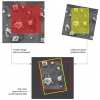

good
good